Book contents
- Frontmatter
- Contents
- List of contributors
- 1 Introduction
- 2 Electrodes
- 3 Intracellular recording
- 4 Extracellular spikes and CSD
- 5 Local field potentials
- 6 EEG and MEG: forward modeling
- 7 MEG and EEG: source estimation
- 8 Intrinsic signal optical imaging
- 9 Voltage-sensitive dye imaging
- 10 Calcium imaging
- 11 Functional magnetic resonance imaging
- 12 Perspectives
- Plate section
- References
2 - Electrodes
Published online by Cambridge University Press: 05 October 2012
- Frontmatter
- Contents
- List of contributors
- 1 Introduction
- 2 Electrodes
- 3 Intracellular recording
- 4 Extracellular spikes and CSD
- 5 Local field potentials
- 6 EEG and MEG: forward modeling
- 7 MEG and EEG: source estimation
- 8 Intrinsic signal optical imaging
- 9 Voltage-sensitive dye imaging
- 10 Calcium imaging
- 11 Functional magnetic resonance imaging
- 12 Perspectives
- Plate section
- References
Summary
Introduction
Electrodes are the first technical interface in a system for recording bioelectrical potentials. The electrochemical and biological processes at the material–tissue interface determine the signal transfer properties and are of utmost importance for the long-term behavior of a chronic implant. Here, “electrode” is used for the whole device that consists of one or multiple active recording sites, a substrate that carries these active sites, as well as interconnections, wires, insulation layers and the connectors to the next stage of a complete recording system, whether it is wire bound or wireless. The application of the electrodes in fundamental neuroscience, diagnosis, therapy, or rehabilitation determines their target specifications. The most important factors are the application site, extracorporal device or implant, acute or chronic contact, size of the electrode (device) and the recording sites, number of active sites on a device, geometrical arrangement of electrodes and type of signal to be recorded. They influence the selection process of electrodes suitable for an envisioned application and help engineers as well as neuroscientists to choose the very best materials for the active sites, substrate and insulation and the most appropriate manufacturing technique. The properties of the recorded signals are also strongly related to this selection process since the tailoring of the transfer characteristics helps to pick up the “right” signal components and to ignore, neglect and reject the “wrong” electrical potentials that might be due to the body itself or the surrounding environment or interference caused by noise from the electrode sites and the amplifier of the recording system.
- Type
- Chapter
- Information
- Handbook of Neural Activity Measurement , pp. 8 - 43Publisher: Cambridge University PressPrint publication year: 2012
References
- 4
- Cited by

